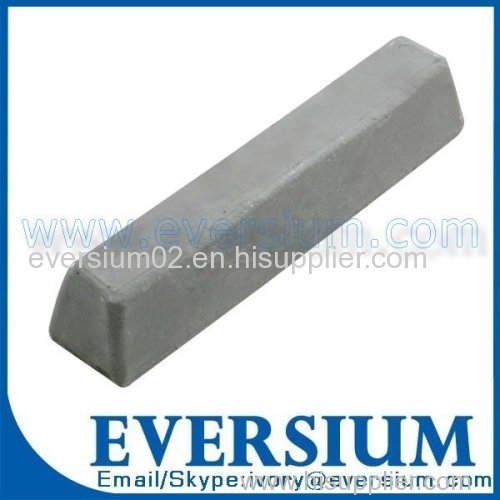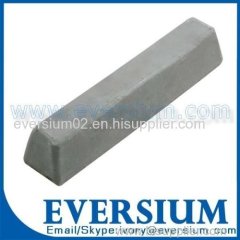
|
Shenyang Eversium Co., Ltd
|
high ductility Mg Metal Magnesium ingot GZ007
| Price: | 10.0 RMB |
| Payment Terms: | T/T,L/C,D/A,WU,Money Gram |
| Place of Origin: | Liaoning, China (Mainland) |
|
|
|
| Add to My Favorites | |
| HiSupplier Escrow |
Product Detail
1. Magnesium alloy
2. AZ91D
3.Ingots sheet bar
Product Description
Magnesium alloys (Elektron,Magnox,Magnuminium)are mixtures of magnesium with other metals (called an alloy), often aluminium, zinc, manganese, silicon, copper, rare earths and zirconium. Magnesium is the lightest structural metal. Magnesium alloys have a hexagonal lattice structure, which affects the fundamental properties of these alloys. Plastic deformation of the hexagonal lattice is more complicated than in cubic latticed metals like aluminium, copper and steel. Therefore magnesium alloys are typically used as cast alloys, but research of wrought alloys has been more extensive since 2003. Cast magnesium alloys are used for many components of modern cars, and magnesium block engines have been used in some high-performance vehicles; die-cast magnesium is also used for camera bodies and components in lenses.
Practically all the commercial magnesium alloys manufactured in the United States contain aluminium (3 to 13 per cent) and manganese (0.1 to 0.4 per cent). Many also contain zinc (0.5 to 3 per cent) and some are hardenable by heat treatment. All the alloys may be used for more than one product form, but alloys AZ63 and AZ92 are most used for sand castings, AZ91 for die castings, and AZ92 generally employed for permanent mold castings (while AZ63 and A10 are sometimes also used in the latter application as well). For forgings, AZ61 is most used, and here alloy M1 is employed where low strength is required and AZ80 for highest strength. For extrusions, a wide range of shapes, bars, and tubes are made from M1 alloy where low strength suffices or where welding to M1 castings is planned. Alloys AZ31, AZ61, and AZ80 are employed for extrusions in the order named, where increase in strength justifies their increased relative costs.
Cast alloys
Magnesium casting proof stress is typically 75-200 MPa, tensile strength 135-285 MPa and elongation 2-10%. Typical density is 1.8 g/cm3 and Young's modulus is 42 GPa. Most common cast alloys are: AZ63, AZ81, AZ91, AM50, AM60, ZK51, ZK61, ZE41, ZC63, HK31, HZ32, QE22, QH21, WE54, WE43, Elektron 21.
Wrought alloys
Magnesium wrought alloy proof stress is typically 160-240 MPa, tensile strength is 180-440 MPa[citation needed] and elongation is 7-40%. The most common wrought alloys are: AZ31, AZ61, AZ80, Elektron 675, ZK60, M1A, HK31, HM21, ZE41, ZC71.
Wrought magnesium alloys have a special feature. Their compressive proof strength is smaller than tensile proof strength. After forming, wrought magnesium alloys have a stringy texture in the deformation direction, which increases the tensile proof strength. In compression the proof strength is smaller because of twinning, which happens more easily in compression than in tension in magnesium alloys because of the hexagonal lattice structure.
Extrusions of rapidly solidified powders reach tensile strengths of up to 740 MPa due to their amorphous character,[4] which is twice as strong as the strongest traditional magnesium alloys and comparable to the strongest aluminium alloys.
Heat resistant magnesium alloy
Superior creep strength of a heat resistant AS31, AX52, AJ52, AE42, ZE41, WE43 magnesium alloy is ascribed to the grain boundary eutectic Al2Ca phase covering the primary α-Mg grains. The eutectic phase is stable in morphology at temperatures below 473 K, while it collapses during long term exposure at temperatures higher than 473 K. The microstructural change of the alloy during high temperature exposure is characterized by the decrease in the grain boundary coverage by the eutectic phase. The creep strength of the alloy decreases with the decrease in the grain boundary coverage, and the correlation between the creep strength and the grain boundary coverage is discussed.
Several families of magnesium alloys have been developed to operate at the elevated temperatures experienced in automotive drive train applications. These alloys are based on additions of certain elements, in particular silicon, calcium, rare earths and strontium. This paper surveys the different types of high temperature alloys comparing elevated temperature properties, castability and factors influencing cost. While high temperature properties have attracted the most attention, the ability to produce sound castings is equally important. Castability testing was conducted on several alloys including AE44, AS31, AJ62, MRI153, AM-HP2+ and AXJ530. Factors influencing alloy cost are also very important. During 2011 a rise in rare earth prices caused a significant shift in costs. Rare earth prices have declined greatly in recent months and the outlook for these alloys is increasingly positive with Western producers commencing production. When considering creep performance, cost and castability together the alloy AE44-2 (made using only two rare earth elements: cerium and lanthanum) stands out as the best performing alloy.
New Die-castable Mg-Zn-Al-Ca-RE Alloys for High Temperature Applications
The Mg-Al-Sr alloys (AJ52, AJ62) show different microstructure based on the Sr/Al ratio.
Alloy Mg Al% Sr% Mn%
AJ62 Balance 6 2 0.34
AJ52 Balance 5 2 0.4
AJ alloys (AJ52 and AJ62) are die castable alloys of magnesium that have good creep resistance at high temperature. They contains magnesium, aluminum, and strontium.
In the names the 'J' refers to Strontium. AJ52 has higher creep resistance, and AJ62 has better castability. Both are used in the BMWmagnesium–aluminum composite engine block.
The AJ62 contains approximately 6% aluminum and about 2,5% strontium. The Mg-Al-Sr alloys exhibit good elevated-temperature tensile properties, excellent creep resistance (better than Mg-Al-RE) and good castability. The alloys have also Zn, Si And Mn. Strontium is added for creep resistance in die casting and gravity casting alloys or to reduced shrinkage porosity. Sr level may range from 0,02% to 3%. The Mg-Al-Sr alloys (AJ52, AJ62) show different microstructure based on the Sr/Al ratio. For Sr/Al ratio below 0.3, the microstructure consists of α-Mg with precipitates of Al4Sr phase. When the Sr/Al ratio increases, a second intermetallic phase (probably Al3Mg13Sr) is observed together with Al4Sr phase. This ratio also controls the precipitation of Mg17Al12 phase. When Sr/Al ratio is very low this phase occur in the α-Mg matrix
Magnesium-lithium alloys
Adding 10% of lithium to magnesium produces an alloy that can be used as an improved anode in batteries with a manganese-dioxide cathode. Magnesium-lithium alloys are generally soft and ductile, and the density of 1.4 is appealing for space applications.
Quantum mechanical simulations have been used to predict the formation of ordered magnesium-lithium alloys. Of interest relative to manufacturing, it is predicted that addition of more than 13 at. % lithium results in ordered-phases with a cubic structure.
Non-combustible magnesium alloys
Adding 2% of calcium (Ca) by mass to magnesium alloy AM60 results in the non-combustible magnesium alloy AMCa602. The higher oxidation reactivity of Ca causes a coat of calcium oxide to form before Mg ignites. The ignition temperature of the alloy is elevated by 200-300K. Oxygen-free atmosphere is not necessary for machining operations.
Advantage
Magnesium alloy is a light weight alloy with a density 2/3 of Aluminum and 1/4 of steel. The strength-to-weight ratio of the precipitation-hardened magnesium alloys is comparable with that of the strong alloys of aluminum or with the alloy steels. Magnesium alloys, however, have a lower density, stand greater column loading per unit weight and have a higher specific modulus.
Despite the active nature of the metal, magnesium and its alloys have good resistance to corrosion. The rate of corrosion is slow compared with rusting of mild steel in the same atmosphere. Immersion in salt water is problematic, but a great improvement in resistance to salt-water corrosion has been achieved, especially for wrought materials, by reducing some impurities, particularly nickel and copper, to very low proportions.
The strength-to-weight ratio of the precipitation-hardened magnesium alloys is comparable with that of the strong alloys of aluminium or with the alloy steels. Magnesium alloys, however, have a lower density, stand greater column loading per unit weight and have a higher specific modulus. They are also used when great strength is not necessary, but where a thick, light form is desired, or when higher stiffness is needed. Examples are complicated castings, such as housings or cases for aircraft, and parts for rapidly rotating or reciprocating machines. The strength of magnesium alloys is reduced at somewhat elevated temperatures; temperatures as low as 200 °F (93 °C) produce considerable reduction in the yield strength.
Despite the active nature of the metal, magnesium and its alloys have good resistance to corrosion. The rate of corrosion is slow compared with rusting of mild steel in the same atmosphere. Immersion in salt water is problematic, but a great improvement in resistance to salt-water corrosion has been achieved, especially for wrought materials, by reducing some impurities, particularly nickel and copper, to very low proportions.
Corrosion troubles may be expected even with protective treatment in poorly designed assemblies where moist air is trapped or where rain is allowed to collect. Where such designs are avoided, unpainted magnesium alloy parts that are oily or greasy operate indefinitely with no sign of corrosion. Magnesium alloy parts are usually painted, however, except where the conditions of exposure are mild. To assure proper adherence of the paint, the part is cleaned by grinding, buffing, or blasting, then given an acid dichromate dip.
Technical difficulties in the removal of chloride inclusions from the manufactured metal delayed progress in the development and engineering uses of magnesium and its alloys in the period when a great advance was being made in the application of aluminium base alloys. With the eventual solution of this problem the way became clear, and an impetus was given to the discovery and exploitation of new alloys, which, once again, has been reinforced by the requirements of the aircraft and nuclear power industries in the current period.
Magnesium's particular merits are similar to those of aluminium alloys: low specific gravity with satisfactory strength. Magnesium provides advantages over aluminium, in being of even lower density (approx. 1800 kg/m³) than aluminium (about 2800 kg/m³). Mechanical properties of magnesium alloys, however, are below those of the strongest of the aluminium alloys.
Individual contributions of gadolinium and yttrium to age hardening and high temperature strength of magnesium alloys containing both elements are investigated using alloys containing different Gd : Y mole ratios of 1:0, 1:1, 1:3, and 0:1 with a constant Y+Gd content of 2.75 mol%. All investigated alloys exhibit remarkable age hardening by precipitation of β phase with DO19 crystal structure and β phase with BCO crystal structure, even at aging temperatures higher than 200 °C. Both precipitates are observed in peak-aged specimens. The precipitates contributing to age hardening are fine and their amount increases as Gd content increases, and this result in increased peak hardness, tensile strength and 0.2% proof stress but decreased elongation. On the other hand, higher Y content increases the elongation of the alloys but results in decreased strength.
Application
Magnesium alloys are used for both cast and forged components, with the aluminium-containing alloys usually used for casting and the zirconium-containing ones for forgings; the zirconium-based alloys can be used at higher temperatures and are popular in aerospace. Magnesium+yttrium+rare-earth+zirconium alloys such as WE54 and WE43 (the latter with composition Mg 93.6%, Y 4%, Nd 2.25%, 0.15% Zr) can operate without creep at up to 300C and are reasonably corrosion-resistant.
Cast magnesium alloys are used for many components of modern cars, and magnesium block engines have been used in some high-performance vehicles; die-cast magnesium is also used for camera bodies and components in lenses.
Equipment
 High quality control
High quality control

Packaging&shipping
Inner Packing: PE film/PE foam/at buyer's option
Outer packing: Fiber cartoon/Pallet/at buyer's option



